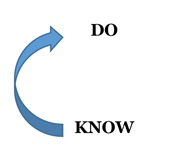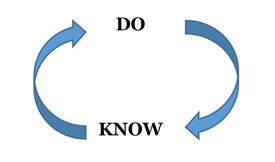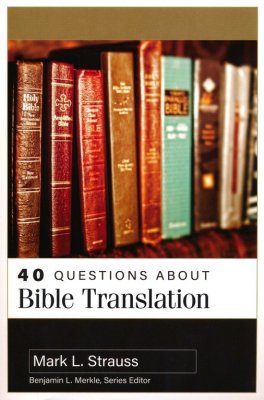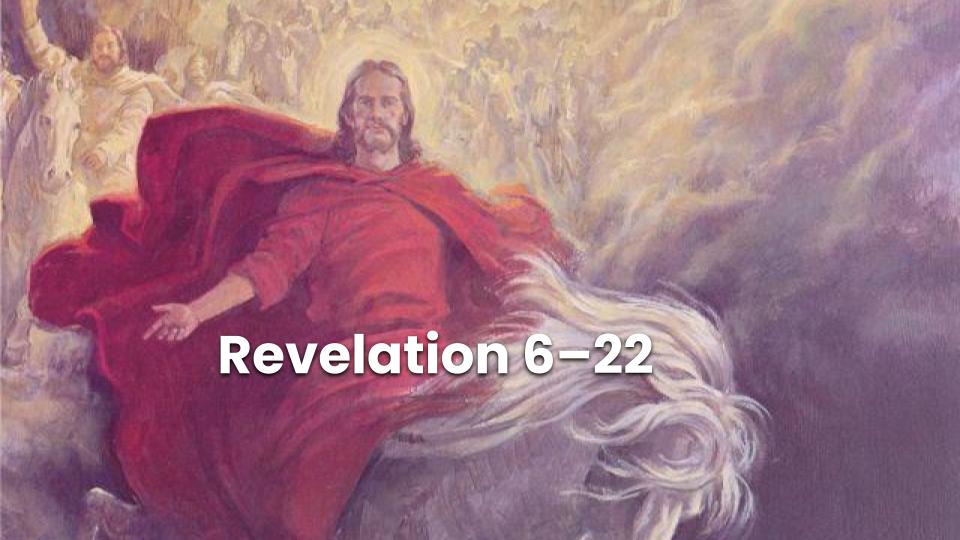In a previous post I talked about the importance of abiding by the precepts, or living the teachings of the Book of Mormon. I think we see several powerful examples of this in the first chapters of the Book of Mormon. Consider these two elements of gospel learning:
DO
KNOW
Does knowing lead to doing, or does doing lead to knowing? Perhaps the most famous Nephi scripture is 1 Nephi 3:7, “I will go and do the things which the Lord hath commanded for I know.” So, in that case, because Nephi knew, he would do, right. Knowing drove the doing.

But just a few verses previously, Nephi said, “having great desires to know of the mysteries of God, wherefore, I did cry unto the Lord; and behold he did visit me“ (1 Nephi 2:16). In this case Nephi did (cry unto the Lord) and in response he knew more of the Lord.

In reality, it’s a symbiotic relationship. Sometimes knowing leads to doing, and sometimes doing leads to knowing. Let’s look at three additional examples that take place in these early chapters with Nephi.
In 1 Nephi Chapter 4:6, Nephi tells us “I was led by the spirit not knowing beforehand the things which I should do. Nevertheless, I went forth.” In that case, doing drove the knowing.
But a few verses later we read that as Nephi contemplated what to do with Laban he said, “I…knew that the law was engraven upon the plates of brass. And again, I knew that the Lord had delivered Laban into my hands for this cause…Therefore I did obey the voice of the Spirit” (1 Nephi 4:16–18). Knowing drove the doing.
My favorite example of this principle is Sariah. It was about 275 miles from Jerusalem to where Lehi and Sariah camped out while waiting for Nephi and his brothers to retrieve the brass plates. That’s at least an eleven day journey, so Sariah had to wait a long time to find out that her sons had safely returned to her. No wonder she “supposed that [Nephi and his brothers] we had perished in the wilderness” (1 Nephi 5:2).
When her sons returned, she joyfully exclaimed, “Now I know of a surety that the Lord hath commanded my husband to flee into the wilderness” (1 Nephi 5:8). Think about that phase—“Now I know.” What does that tell us about what Sariah knew on the day that she left? It had been about 40 days since she left Jerusalem, and she only now knew that it was the right thing. She did and then she knew.
While it goes both ways, I believe that in the scriptures, the more prevalent pattern is doing leading to knowing. Adam and Eve sacrificed for many days before they knew why it was important. Noah built an ark prior to knowing it would rain and Moses led the children out of Egypt before he knew God would part the Red Sea. Naaman washed in the River Jordan before he became clean, just as ten lepers were cleansed “as they went” (Luke 17:14). Moroni’s famous promise is an invitation to do so that we will know (see Moroni 10:3-5).
In addition to illustrating the importance of our individually choosing to exercise our faith and act, this do-know model has significant applications for teaching in all its settings. A child who grows up in the church will spend thousands of hours listening to lessons; ostensibly the point of these learning opportunities is to increase knowledge, which hopefully will in turn later increase action. However, in many instances we need to reframe our focus in teaching and learning, because often it is acting that leads to knowledge and not the other way around. Teachers must find ways to help their students act.
We put way too much importance on what we say. We think that by telling people things that somehow that will connect and get inside. My observation is that the role of a parent [teacher] includes talking and telling, but it extends beyond that to inviting a child [student] to act in accordance with truth. And only when the child [student] acts in accordance with the truth that has been explained or taught can the child [student] come to know for himself or herself the truthfulness of what they have heard and what they are doing. . . .
It’s only when in that process of communicating, loving, and working with a child [student] you help them act in accordance with truth that they get it for themselves. It moves from their head to their heart.
As parents and teachers preparing lessons, let’s keep in the very forefront of our minds that while part of our goal is to help our children/students learn new things so that they will do the right thing, another key aspect of our role is to help our children/students do things, so that they will know.
I’ve written some articles on the importance of teachers helping students do thing (here and here). You might also enjoy the LDS Perspectives podcast I did on how these principles relate to learning and teaching. I welcome your thoughts on how to help those we teach do, so that they will know.
Sign up to receive monthly emails with more posts like this one.





